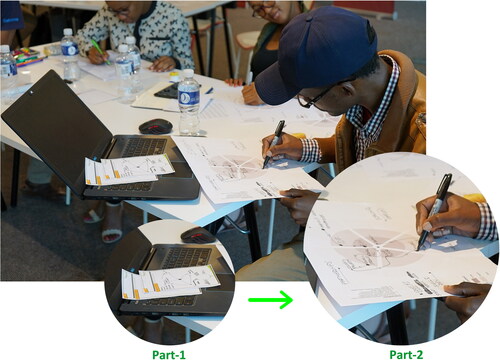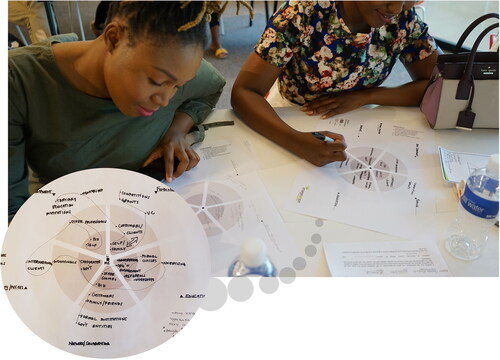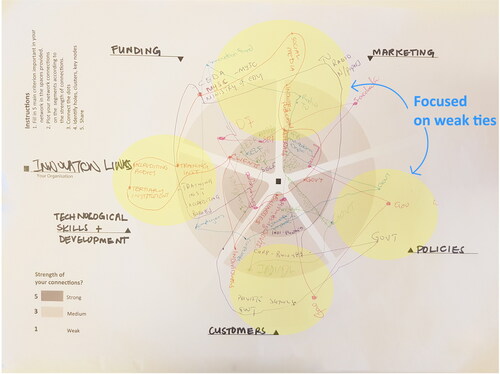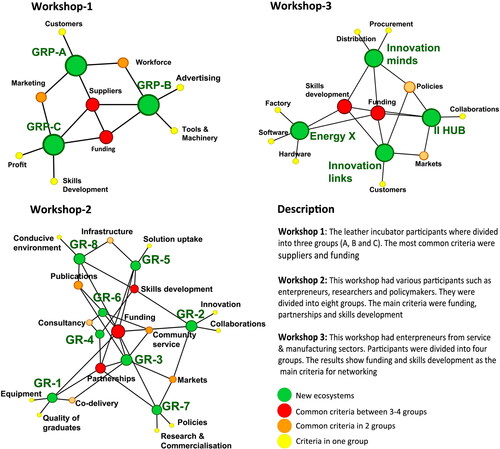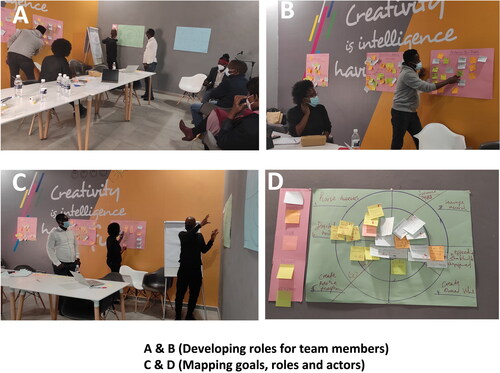Abstract
Small and medium-sized enterprises (SMEs) draw on inter-firm resources to innovate. As a result, SMEs find themselves embedded in complex local ecosystems that they do not fully understand. We used the co-design visualisation approach to help actors visualise, understand, and activate entrepreneurial actions to address this challenge. The study engaged SMEs, researchers, and innovation policymakers as examples of key actors in a local ecosystem. The first co-design workshop was at a Botswana leather incubator with 15 manufacturing SMEs. Then we evaluated our approach with 65 participants from research and policy environments across seven African countries. Lastly, we conducted a workshop with 20 SMEs from Botswana Innovation Hub. Our findings suggest that using ecosystem visualisations as rigorous heuristics empowers actors to identify opportunities for entrepreneurship. Implications for this research emphasise the role of co-design visualisations in navigating complex and less developed entrepreneurial ecosystems to drive regional strategy and innovation.
Introduction
This article is part of ongoing entrepreneurial ecosystem research in Botswana that explores how the design role can influence entrepreneurship and innovation. Although the definition of the entrepreneurial ecosystem is not well established, most authors agree on its systemic nature of interdependent actors and factors which enable productive entrepreneurship in a specific region (Stam Citation2015; Cohen Citation2006; Spigel Citation2017; Isenberg Citation2010). Understanding local ecosystems promotes entrepreneurial actions that contribute to regional innovation and development (Arabi and Abdalla Citation2020; Simatupang, Schwab, and Lantu Citation2015).
In this research, innovation is defined as ‘identifying new resources that are different from existing ones and acting upon them to increase entrepreneurship’ (Nthubu, Citation2021a, 750). As networks of actors in entrepreneurial ecosystems gain a critical mass (Stam and Van de Ven Citation2021), early-stage entrepreneurs find complex environments challenging to manoeuvre (Koria, Vasques, and Telalbasic Citation2020). Small and medium-sized enterprises (SMEs) face enormous challenges such as scarce resources (Webb et al. Citation2009). Nevertheless, scant research focuses on exploring interdependencies and interconnections in entrepreneurial ecosystems to address this problem (Roundy Citation2020), let alone the value of leadership roles in contexts where resources are scarce (Miles and Morrison Citation2020).
There is limited research in defining exchanges between entrepreneurial actors, making it challenging for policymakers to nurture entrepreneurship (Cavallo, Ghezzi, and Rossi-Lamastra Citation2021). This article explores the role of design and visualisations in helping SME ecosystem actors navigate local ecosystems. The novelty of this approach lies in assembling heterogeneous SMEs’ ecosystem actors to collaboratively visualise their positions, roles and evaluate and act upon opportunities for collaboration.
The design role contributes to systemic innovation methods through service design, design for social innovation and policy design (Karadima and Bofylatos Citation2019). According to Boland and Collopy (Citation2004), managers can develop new solutions rather than being stuck in default alternatives if they assume the role of designers. Other scholars have shown how design tools can facilitate and shape the understanding of connections between key actors involved in a system (Ballantyne-Brodie and Telalbasic Citation2017; Pérez et al. Citation2019; Bernarda et al. Citation2017; Hyvärinen, Lee, and Mattelmäki Citation2015). Minder and Heidemann (Citation2018) also show that introducing the designer in facilitating multidisciplinary innovations leads to increased energies, motivating diverse actors to exchange ideas more openly.
This article demonstrates that entrepreneurs, particularly SMEs, hold tacit knowledge about their local ecosystems, albeit they lack the tools to extract and use it to assemble, curate ecosystem structures (i.e. actors, roles, and ties), evaluate and act upon opportunities for entrepreneurship.
Literature review
The word ‘ecosystem’ comes from the field of biology, which defines the interaction and interdependence of living and non-living components in a specific environment (Tansley Citation1935). In business and innovation, the ecosystem metaphor emphasises co-evolutionary elements of emergence, growth, and survival (Stam and Van de Ven Citation2021; Adner and Feiler Citation2019; Dedehayir, Ortt, and Seppänen Citation2017). This emphasis shifts the perspective of business and innovation research towards studying interconnections and interdependencies of actors, technologies, and institutions in a system (Jacobides, Cennamo, and Gawer Citation2018). Building from Moore (Citation1993)’s concept of business ecosystems, the ecosystem metaphor evolved in other forms in recent years, e.g. entrepreneurial ecosystems (Prahalad Citation2005; Isenberg Citation2010; Stam Citation2015; Spigel Citation2017), innovation ecosystems (Jacobides, Cennamo, and Gawer Citation2018), platform ecosystems (Gawer and Cusumano Citation2014) and service ecosystems (Akaka and Vargo Citation2014) to explore and manage business and innovation systems.
Entrepreneurial ecosystems
We focus on the entrepreneurial ecosystem and how this influences the development of the local SME ecosystem in Botswana, a less developed entrepreneurial ecosystem. In Botswana, challenges such as lack of access to finance, lack of policies, and lack of innovation and entrepreneurial skills hamper entrepreneurship (Nthubu Citation2021a). Similar challenges are highlighted in a study with early-stage entrepreneurs in Brazil’s low resource settings (Koria, Vasques, and Telalbasic Citation2020).
Cohen (Citation2006, 3) defines entrepreneurial ecosystems as ‘an interconnected group of actors in a local geographic community committed to sustainable development through the support and facilitation of new sustainable ventures’. Stam (Citation2015, 5) defines this as ‘a set of interdependent actors and factors coordinated in such a way that they enable productive entrepreneurship within a particular territory’. Spigel (Citation2017, 50) also refers to ‘combinations of social, political, economic and cultural elements within a region that support the development and growth of innovative start-ups and encourage nascent entrepreneurs’. Most of these authors refer to a set of interdependent actors who depend on regional factors to innovate and grow.
Several ecosystem models emerged in recent years to explain the key elements of an entrepreneurial ecosystem. However, there is still limited knowledge of assessing an entrepreneurial ecosystem (Cavallo, Ghezzi, and Rossi-Lamastra Citation2021). For example, Isenberg’s (Citation2010) model highlight culture, policies, leadership, finance, human capital, and markets as key. The model is designed around what the entrepreneurs view as important, emphasising that ecosystems have different interplays between processes, actors, and organisations. The World Economic Forum proposes eight pillars of building a successful ecosystem (Pugh et al. Citation2021). Stam (Citation2015) developed ten elements to measure the entrepreneurial ecosystem outputs. However, Stam acknowledges that although these elements are generalizable to most ecosystems, they require context-specific measurements (Ibid.). Spigel (Citation2017) examined three examples of ecosystems where they found that differences in ecosystems’ cultural, social, and material attributes influence entrepreneurs differently. This is because entrepreneurship is dependent on entrepreneurs’ characteristics and external factors (Thukral Citation2021).
Extant literature on entrepreneurial ecosystems focuses on high-growth firms (Spigel Citation2017; Audretsch and Belitski Citation2017), thus ignoring the networks of micro-businesses critical for developing local ecosystems (Aljarwan et al. Citation2019; Pustovrh, Rangus, and Drnovšek Citation2020). In Nthubu (Citation2021a), five main elements of designing productive entrepreneurial ecosystems in Botswana were identified, i.e. initiating, designing, reviewing, activating, and sustaining ecosystems. Initiating ecosystems is about convening and building dialogue, and designing is about visualising actors' roles, ties, and positions. Reviewing and activating ecosystems is about exploring interdependences and starting activities together, and finally, sustaining ecosystems is about strengthening long term ties (Ibid.). However, the entrepreneurial ecosystem concept still requires more theoretical expansions (Kansheba and Wald Citation2020), and its analysis and understanding remain a challenge for SMEs, policymakers, and scholars, especially in evaluating networks of actors in entrepreneurial ecosystems (Neumeyer et al. Citation2019).
The models highlighted above represent a paradigm shift (Audretsch and Belitski Citation2017), thus calling for more action-oriented design research and how the design role can add value in promoting entrepreneurial actions.
Actor-network theory (ANT) and the strong and weak ties construct in entrepreneurial ecosystems
Scant theoretical and analytical reference is made to network literature (Alvedalen and Boschma Citation2017). According to Callon and Latour (Citation1981, 286), ‘actors are individuals who influence elements occupying space around them’. The actor-network theory provides knowledge about actors’ relations in a network (Simba and Ojong Citation2017). ANT suggests that looking at material actors as inactive in the entrepreneurial process is ill-advised (Lamine et al. Citation2019). Lamine and colleagues (2019) also highlight that opportunities emerge as diverse actors cooperate in networks. Most importantly, Van der Duim, Ren, and Jóhannesson (Citation2012, 4) define ANT as ‘a translation device that provides the means to move around, make connections and follow relations between seemingly opposed positions or dualisms’. Pierre Johnson et al. (Citation2017) used a visual design method from actor-network theory to develop design models with collaborators, acting as boundary objects to engage complex and collaborative contexts.
According to Callon and Latour (Citation1981), a good ANT identifies actors and connections in new and interesting ways. In this regard, ANT acts as a useful resource to open the entrepreneurial process and align divergent views (Jóhannesson Citation2012). Even so, ANT has been rarely used in the extant entrepreneurship literature (Korsgaard Citation2011). Related studies that used ANT in exploring entrepreneurship include Smith, Kempster, and Barnes (Citation2017), who looked at understanding entrepreneurship leadership learning through ANT. Murdock and Varnes (Citation2018) used ANT to explore how different framing implicate diverse human and non-human actors in entrepreneurship. We use ANT as a translation device, i.e. helping us move around, make connections and act upon new relations.
The theory of weak ties suggests that those who move in different circles (acquittances and strangers) from their own (close friends and relatives) have access to different kinds of information and resources (Granovetter Citation1973). More actors can be reached through weak ties, thus leveraging new resources different from close ties. Although Granovetter’s strength of weak ties found that most jobs come from a weak tie than a strong tie, recent work by Gee et al. (Citation2017) show that the probability of a sequential job from a single strong tie is higher than from a single weak tie. As Sundararajan (Citation2020) suggested, insights through exploring strong and weak ties rationalities may reshape human society. This article proposes a framework that combines entrepreneurial knowledge, actor-network theory, and the strong and weak ties constructs to navigate complex ecosystems.
The role of visualisations in ecosystems
Visualisations can be either used as explanatory, exploratory and exhibition interfaces to communicate, explore and display knowledge (Kirk Citation2016). This article uses visualisations as boundary objects and exploratory tools. Boundary objects act as bridges between transdisciplinary actors (Islind et al. Citation2019), thus triggering curiosities and discussions amongst them (Krzywinski et al. Citation2012). This approach provides heuristic value about complex ecosystems because it is often challenging to start conversations in transdisciplinary spaces (Vink et al. Citation2019). Sanders and Stappers (Citation2008) emphasise that visualisations are essential in prompting discussions because they reveal previously hidden information. Visualisations also help to characterise ecosystem networks for discovery and new insights (Padilla et al. Citation2018; Nthubu et al. Citation2021).
The role of design in entrepreneurial ecosystems
Telalbasic (Citation2016) argues that the design role shapes meaningful interactions between all actors in a system that includes creating new business models. Minder and Heidemann (Citation2018) elucidate that collaboration between designers and other actors facilitate boundary-spanning innovation. Pankov et al. (Citation2021) highlight the vagueness of how entrepreneurs act in shaping their ecosystem.
In other related studies (Hyvärinen, Lee, and Mattelmäki Citation2015; Steen, Manschot, and De Koning Citation2011), design plays a significant role in creating effective platforms for transdisciplinary innovation. Therefore, the emerging role of design in entrepreneurial ecosystems is in developing methods and tools that promote transdisciplinarity and collaboration. This role can empower people with tools to develop new opportunities relevant to their needs beyond the presence of a trained designer (Ballantyne-Brodie and Telalbasic Citation2017; Cruickshank, Coupe, and Hennessy Citation2013).
Collaborative design refers to ‘the creativity of designers and people not trained in design working together in the design development process’ (Sanders and Stappers Citation2008, 6). This view acknowledges that all actors have creative abilities, shifting from a designer as a creative expert to a designer as a stager and facilitator of dialogue and negotiations (Pedersen Citation2020).
It is important here to emphasise that we are not taking the approach of the ‘super-designer’ driving entrepreneurship but how design practices (based on visualisation methods) drive entrepreneurship.
Methodology
We approach the ecosystem phenomena from a constructivist position to study networks of actors, e.g. firms, people, and sectors involved from diverse viewpoints. Simba and Ojong (Citation2017) highlight those real-world problems are too complex to be understood from a single perspective. Our approach uses visualisations as rigorous heuristics, drawing from the tenets of constructionism where knowledge creation and knowing are social constructions (Mascolo and Fischer Citation2005). We adopted an in-depth case study approach by purposefully selecting the entrepreneurial ecosystem in Botswana. Exploring this type of ecosystem is important to address the scarcity of empirical work on entrepreneurial ecosystems in less developed environments (Aljarwan et al. Citation2019).
We used co-design workshops to convene key entrepreneurial ecosystem actors in one space to visualise, understand and activate ecosystems. Based on the five levels (initiate, design, review, activate and sustain) Jigsaw framework reported in Nthubu (Citation2021a), the aim was to help entrepreneurs navigate the complexity of initiating, designing, reviewing, and activating ecosystems. Co-design workshops were chosen because they are essential in promoting collective creativity and innovation in entrepreneurial ecosystems (Simba and Ojong Citation2017), instrumental in creating opportunities for collaboration and learning.
Data collection
We took pictures of visualisation outputs during co-design workshops, recorded presentations, and took notes on how participants engaged each other. We also distributed evaluation forms at the end of the workshops to measure our design approach's impact in helping actors navigate complexity.
Data analysis
The analysis was first done during workshops with participants through presentations and discussions of visualisations. Then, the researchers coded the workshop data (visuals and notes) to identify how participants designed ecosystems. The workshop recordings, notes and visualisations were coded to generate themes following a five-step process, i.e. data familiarisation, code generation, theme generation, theme revision and theme definition (Braun and Clarke Citation2006). The coding process captured the complex meaning of textual and visual data. We also analysed actors’ criteria for ecosystems using Gephi 0.9.2, an open-source software for graph and network analysis, to compare important ecosystem criteria across three workshops. The thematic and visual codes were aggregated into three main dimensions as follows; i) visualising, ii) understanding and iii) activating entrepreneurial ecosystems. To ensure validity, we discussed the results of the workshops with participants. Ethical approval for this research was applied for and granted by Lancaster University Ethics Committee.
Co-design approach
Based on the Jigsaw framework (Nthubu, Citation2021a), ANT, and the strong and weak ties construct, we framed the co-design approach using paper-based design tools to bridge the gap between theory and practice in entrepreneurial ecosystems. This framing acts as a structure for entrepreneurs to i) visualise, understand, and activate entrepreneurial ecosystems, thus creating a transdisciplinary space to navigate complex ecosystems. Visualisation tools ( and ) used in this article act as translation devices to help participants make sense of ecosystem networks. The first tool used is called ‘My innovation network’ (). This is an A5 paper-based tool that introduces the idea of visualising ecosystem networks in terms of mapping actors’ positions and ties. This tool is important to quickly break the ice and introduce workshop participants to the power of visualisations in revealing hidden network structures.
Figure 1. My innovation network: An A5 paper-based tool for visualising actors’s positions in their respective networks (Nthubu, Citation2021b).
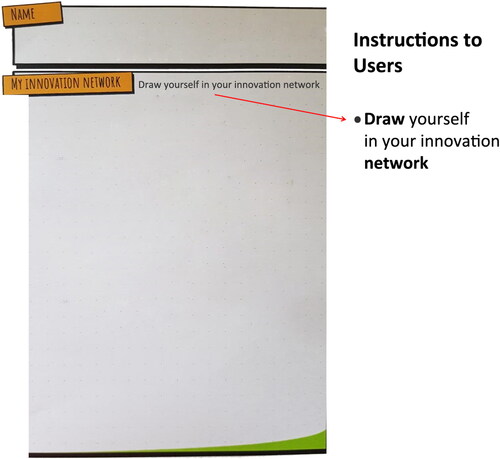
Figure 2. The ecosystem mapping tool: An A3 paper-based tool for navigating entrepreneurial ecosystems (Nthubu, Citation2021b).
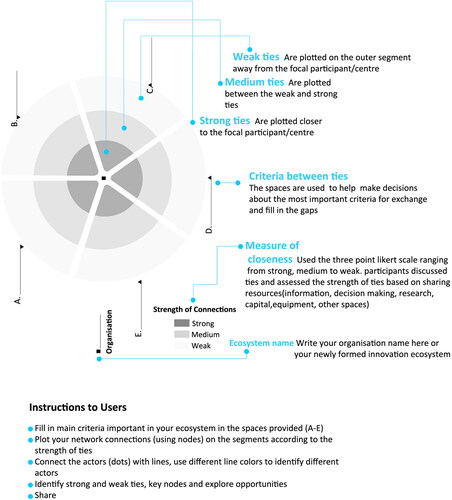
The second tool used is called the ‘ecosystem mapping’ tool (). This is an A3 paper-based tool introduced to help workshop participants visualise, understand, and activate weak ties, main actors and new roles. Unlike ‘My innovation network’ tool, this ecosystem mapping tool is useful in measuring closeness with partners. The ‘ecosystem mapping’ tool is divided into five segments representing criteria for the ecosystem, and these design spaces allow actors to map contacts against the relationship criteria. Also, the tool is divided into three distinct dimensions of the strength of ties to allow participants to characterise ties. The inner-most segment delineates the strong ties, and the outer-most segment delineates weak ties. Explaining ecosystems in distinct but interactive dimensions allows easy and practical analysis and understanding of ecosystem actors, roles, and ties.
Description of participants
Workshop-1 was with 15 manufacturing SMEs and two incubator managers from the leather incubator. We purposefully selected the leather incubator because it is the only government-funded and themed incubator promoting leather manufacturing in Botswana. Participants were identified through a face-to-face meeting during the Botswana consumer fair held on the 30th of August 2018 in Gaborone. We collected participants’ emails and later invited them to attend the workshops held on the 03rd of February 2020. All 15 SMEs located at the leather incubator attended. Workshop-2 took place on the 05th of February 2020 in Gaborone with 65 participants from seven countries (Nigeria, Mozambique, Uganda, Kenya, Malawi, Zambia, Botswana). These participants were purposefully selected and recruited through the Recirculate project from Lancaster Environment Centre who already had prior relationships and activities. All participants agreed through email correspondences to attend the workshop. We had an audience of researchers, non-governmental organisations, SMEs, and policymakers who are an important part of entrepreneurial ecosystems across Africa.
Workshop-3 was held on the 07th of February 2020 in Gaborone with 20 entrepreneurs from Botswana Innovation Hub, the only government-funded innovation hub that promotes multi-sector entrepreneurship. This diverse group of participants was purposefully selected for comparative analysis. Participants were identified and recruited during the authors’ tour of the hub on the 24th of August 2018.
These three workshops were important for comparative analysis on how various ecosystem roles combine to form ecosystem-level capabilities.
Co-design activities
The co-design activities were divided into three parts. Part-1 introduced participants to visualising ecosystems using the ‘My innovation network’ tool. The aim was to initiate participants to think about their positions relative to others and represent these visually. Examples of the visualisation outputs from the third workshop are labelled part-1 (). Participants were encouraged to use these outputs to inform part-2 of the workshop.
Part-2 was about visualising actors’ positions and ties. We introduced the ‘ecosystem mapping’ tool, inviting participants to extend the knowledge gained in part-1 to design (map actors’ positions and ties) and review (assess and evaluate ties and roles) ecosystem structures. They were also encouraged to use outputs from part-1 as design prompts in part-2 ().
As indicated on the tools’ instructions (), part-2 of the workshop prompted participants to list important criteria for the ecosystem individually and write the main criteria on the segments provided. Then they were asked to identify key contacts and roles and map these against the criteria. Finally, they used lines to connect actors (). Participants evaluated visualisations to identify collaborations with the rest of the workshop participants.
During part 3, we introduced hypothetical groups of ecosystems. This was important to activate new relationships between entrepreneurs. Part-3 was also important to evaluate how the ‘ecosystem mapping’ tool helped actors move past dualisms and diverse goals to align ecosystem interests. The aim was to get diverse actors to work together amid their transdisciplinarity. Participants used the tool () to develop a new ecosystem structure. Like in part 2, they started by developing a list of important criteria for a combined ecosystem. Then they identified key roles and actors and mapped these against the criteria. Part-2 outputs were helpful in quickly developing a list of actors connected to individual entrepreneurs during part-3 ().
Figure 5. Photos showing participants during part-3 of all workshops (W1. W2, W3) designing ecosystems in groups.
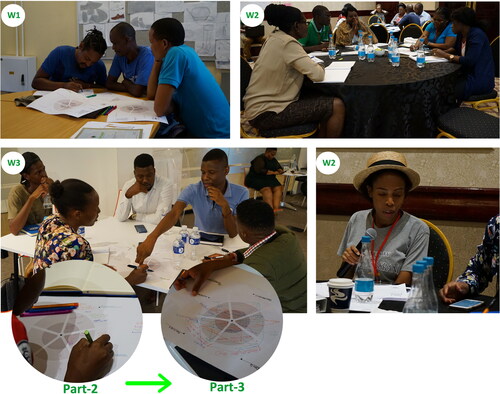
We also introduced different colours to represent the heterogeneity of actors and contacts. This was important to enable analysis and review of visualisations. Each group presented and discussed new ecosystem structures. An example of the visualisation produced in groups is shown in . The workshops concluded with discussing future steps to activate new ideas.
Findings
From co-design workshops, participants identified three main themes, i.e. i) visualising main criteria and roles for ecosystems, ii) understanding connections and roles, iii) activating new roles and connections.
Visualising criteria and roles
Visualising main criteria and roles is the first aggregate dimension from the analysis of the co-design workshops. The aim of helping participants navigate and identify important criteria and roles was achieved. Participants identified funding, suppliers, skills development, and partnerships as essential to building successful entrepreneurial ecosystems (). Most participants portrayed their networks as small, isolated, and lacking key actors, e.g. funders and suppliers. Participants agreed that using design tools makes it easy to align interests and goals, assess network size, connectedness and identify key actors in ecosystem networks ().
Understanding roles and connections
Understanding roles and connections is the second aggregate dimension of navigating complexity in entrepreneurial ecosystems. Part-1 visualisations proved helpful as prompts in workshop-1 and 3, making implicit ideas explicit. In workshop-2 (part-2), participants struggled to design ecosystems without part-1 prompts. Analysing workshop-1 results using a Gephi 0.9.2 force-directed graph layout, suppliers and funders were identified as crucial roles to entrepreneurs (). Visuals revealed hidden ties and actors:
I realise that there are other supporting factors and services on the map that I am currently not utilising. It’s either I am not utilising them as much as I am using LEA [Local Enterprise Authority], or they are not supplying the things that I want. Maybe something that I need to be looking into is the relationship between me and the guys in the median and outer area of the tool (Leather shoes manufacturer).
The above quote shows that visualisations aid actors in navigating hidden patterns, for example, identifying neglected opportunity ties in the median part of the map. The ability to see ecosystem structures help evaluate, reshape, and make strategic decisions to form new alliances (Adner and Feiler Citation2019). It is challenging to see these opportunities through other means, e.g. statistical methods (Lurie and Mason Citation2007).
Activating new connections and roles
Activating new connections and roles was identified as the third aggregate dimension to help actors navigate complexity. The aim of getting diverse actors from different firms to co-design ecosystems was realised in all workshops. Using visualisations as building blocks proved useful in exploring opportunity links between actors. Visualisations acted as translation devices (Van der Duim, Ren, and Jóhannesson Citation2012), helping participants start a dialogue, move past differences and conflicting ideas, and make new connections between distant networks. From the analysis of visualisations, participants in workshop-1 suggested new ways to activate and sustain future ecosystem ideas, e.g. seeking partnerships with funders as a group:
One of the things that we are both weak at is the sourcing of funds to develop the business. So, moving forward, we may consolidate our efforts to apply for funding as a group rather than as individuals. We can also access markets together by combining our resources to reduce costs. Each of us has a different clientele base, so accessing each other’s clients may provide more diversity for our clients (Upholstery entrepreneur and Hand weaver).
Unlike in workshop-1, workshop-2 mostly used the tool to explore missing roles and actors that might help them activate and expand the ecosystem. When analysing the visualisation data, access to funding, forming partnerships and skills development were most valued by researchers and policymakers to help them activate ecosystems (). Our research found that since participants were from many African countries in workshop-2, it was challenging to agree on the main criteria for ecosystems in part-1. However, visualisations in part-2 helped participants evaluate and organise their thinking, align different views and reconcile their networks:
We also managed to use the tool to identify common weak ties where we can collaborate across countries with other researchers such as in co-application of funding from international agencies and partnerships in research. Our respective governments could facilitate this (GRP-4-Innovation policymakers, Leather manufacturing SME and researchers from Kenya and Malawi).
Most participants mapped funding, skills development, policies, and markets as the most important criteria (). All three workshops highlighted isolated innovation activities as the main challenge for activating productive entrepreneurial ecosystems.
In some instances, using different colours in mapping contacts and ties confused participants, particularly in workshop-1 and 2. It was challenging to produce legible visualisations to support discussions, assessments, and reviews. However, the idea of mapping the strength of ties helped participants to recognise their strong ties. Moreover, most participants successfully used the simplified theory to identify missing actors and roles in the ecosystem. Participants elaborated:
This tool is very useful in helping us to visualise our possible connections in terms of strong and weak ties. We believe that since we are mostly from the IT environment, our collaboration in exploring the software and hardware criteria is key. There is also an agent need for us to work together in e-manufacturing and digital manufacturing using augmented reality and AI technologies (Energy X group-Ai entrepreneur, AR and Real Estate entrepreneur, Renewable Energy entrepreneur and Chemical Engineer).
From the evaluation exercise conducted at the end of the workshops, more than 90% of participants agreed that the knowledge and opportunities identified from the co-design workshops helped them navigate and expand their ecosystems.
Outcomes
This research emphasised a more hands-on approach to visualising, understanding, and activating entrepreneurial actions. Because of this, the leather incubator managers reported the new value-added through our approach, particularly in helping entrepreneurs to work together in identifying and solving complex problems:
Since your interventions, I am happy to say that the design approach to SME ecosystems project you did change the way I look at ecosystems. The approach was practical, and we are now applying most of this knowledge and interventions to grow the SME ecosystem. The approach broke down areas to problem solve and seemed to relate easily to matters in hand. (Leather Incubator Manager)
Entrepreneurs from the innovation hub formed a WhatsApp group to facilitate conversations and collaborations beyond the co-design workshops to activate and sustain ecosystems. Some also formed new meetup groups and coffee meetings to continue using design tools and principles gained from the co-design workshops:
It has given me a broader perspective on ecosystem actors and the importance of these actor’s relationships in building a vibrant and sustainable SME ecosystem. This has allowed me to rethink and adjust plans on how to communicate and address ecosystem bottlenecks and challenges through strengthening weak network relationships and seeking room for collaborations instead of competing in some cases. (Spectrum Analytics Manager)
Our approach has proved useful to entrepreneurs in visualising, understanding, and activating entrepreneurial ecosystems. This work also led to a new collaboration with Stanbic Bank accelerator in Botswana. This was an important and missing role identified during co-design workshops. We are now collaborating with entrepreneurs located at the Stanbic Bank accelerator to navigate and curate an effective blood donation ecosystem to solve blood shortages in Botswana through this relationship. shows co-design activities at the Stanbic Bank accelerator during the project alignment workshop held on the 8th of July 2021. The blood donation ecosystem project is expected to provide an opportunity to evaluate and generalise our framework to other ecosystem settings.
Discussion
Reflecting on Stam’s (Citation2015, 5) definition of the entrepreneurial ecosystem, our co-design visualisation approach helped convene key ecosystem players to achieve coordination and collaboration. Whitham et al. (Citation2019) found bringing different actors with competing interests and criteria to work together challenging. The visual narratives produced in these workshops proved effective as translation devices to show participants where other actors are in the network and what roles are missing. This finding aligns with Van der Duim, Ren, and Jóhannesson (Citation2012). Entrepreneurs need the knowledge and understanding of ecosystems to navigate complexity, i.e. interact with others more effectively (Kansheba and Wald Citation2020).
Like in other studies (Pugh et al. Citation2021), our approach helped participants identify access to finance, human capital, supplies and markets as critical elements for entrepreneurial growth. Most participants identified funding as a missing role, thus determined to look for funding opportunities elsewhere. Mapping ecosystems with policymakers shows that although the government is the largest market for entrepreneurs in Botswana, they still fail to see, evaluate, and act upon the opportunities provided.
The presence of professionally trained designers and visualisations made participants excited, trusting and interested in what other key actors can offer. This finding agrees with Minder and Heidemann (Citation2018). Since the workshops’ participants had different educational backgrounds and skills, visualisations empowered actors to easily express these differences. This suggested that the co-design visualisation approach effectively helped diverse actors with varied capabilities (Webb et al. Citation2009; Rostek Citation2015) to align different interpretations, dualisms, and goals (Eppler Citation2004). These findings also agree with Boland and Collopy (Citation2004), where authors emphasise that entrepreneurs as managers can develop new solutions rather than being stuck in default alternatives by assuming the role of designers.
Our research outcomes (e.g. MoU, new meetup groups and the blood donation project) demonstrate the value of this design visualisation approach in helping entrepreneurs and researchers meet, visualise their networks, evaluate and act upon new opportunities for collaboration. This finding supports the view that entrepreneurs act upon new opportunities they can see (Alvedalen and Boschma Citation2017).
There were challenges of bringing all key entrepreneurial ecosystem actors together to assess important parts of the ecosystem. For example, producing legible visualisations and getting the attention of all ‘strangers’ to work together was problematic. Our method helped actors create ecosystem heuristics for co-creation and learning past most of these complex challenges. Using theoretical perspectives such as ANT, the strong and weak ties construct, and key elements of the local entrepreneurial ecosystem framework led to a successful co-design experience. This approach made it possible for entrepreneurs with limited understanding and capabilities to access important network theories.
Conclusions
This article has demonstrated how design researchers and entrepreneurial ecosystem actors can collaborate in a transdisciplinary co-design setting to navigate and curate productive entrepreneurial ecosystems. Convening different actors across three workshops created important and new ties amongst entrepreneurs, researchers, and policymakers. We contribute a nuanced methodological approach to entrepreneurship research, combining ANT, the strong and weak ties constructs and the local entrepreneurship knowledge in a more practical way that generates opportunities for effective entrepreneurship. This contribution can be summed up into three main central values, i) visualising, ii) understanding and iii) activating entrepreneurial actions. Our research also fostered other values such as trust, explorative mindsets, and best practices, thus enabling peer to peer conversations and sharing experiences. Entrepreneurs need these capabilities to evaluate and reveal the most important parts of their ecosystems. This is because it is challenging to act upon every single area of the entrepreneurial ecosystem all at once. To the best of our knowledge, no previous work has adopted this co-design visualisation approach in engaging SMEs in Botswana.
Implications for this research are that our approach links theoretical constructs with the local entrepreneurial ecosystem elements, thus empowering practitioners in a less developed ecosystem to easily navigate complexity. This is evidenced by the ongoing collaborative work with Stanbic Bank accelerator, entrepreneurs, and other stakeholders (). Developing entrepreneurial ecosystems directly benefit local communities through activating new networks (Kang et al. Citation2021). We invite design researchers to use this approach to experiment with practitioners and policymakers in other ecosystem setting to improve its generalizability.
This study has limitations. First, our approach engages 100 participants and having more participants representing other entrepreneurial roles may lead to new ideas. Second, although our research builds from co-design workshops, further evaluation through other quantitative methods, e.g. surveys, may increase the rigour of the findings. Producing legible visualisations using paper-based tools was a challenge. Future co-design workshops may focus on experimenting with digital formats, especially due to the COVID-19 pandemic, making it challenging to conduct in-person workshops. Although this research has limitations, it provides value to practitioners and entrepreneurship researchers in visualising, understanding, and activating entrepreneurial actions.
Acknowledgement
This work is based on a research project funded bythe Commonwealth Scholarship Commission in the UK and Imagination Lancaster through Beyond Imagination E3 project.
Disclosure statement
No potential conflict of interest was reported by the author(s).
Additional information
Notes on contributors
Badziili Nthubu
Badziili Nthubu is a post-doctoral research associate at Imagination Lancaster. His research focuses on exploring innovation ecosystems through co-design and visualisation methods and how users might be empowered to shape future ecosystems.
David Perez
David Perez Ojeda is a Lecturer in Radical Co-Design at Imagination Lancaster. His research focuses on making engagement initiatives more inclusive through co-design, participatory design and social innovation.
Daniel Richards
Daniel Richards is a Lecturer in Data Prototyping and Visualisation at Imagination Lancaster. His research interests involve fusing design, unconventional computing and digital fabrication to explore the future of manufacturing.
Leon Cruickshank
Leon Cruickshank is the Director of Research at Imagination Lancaster and principal investigator for Beyond Imagination, a three year £13m E3 project, awarded recognising Imagination as a nationally and internationally excellent research group. His focus is on co-design and involving a broad spectrum of stakeholders in research and creative processes.
References
- Adner, Ron, and Daniel Feiler. 2019. “Interdependence, Perception, and Investment Choices: An Experimental Approach to Decision Making in Innovation Ecosystems.” Organization Science 30 (1): 109–125. doi:10.1287/orsc.2018.1242.
- Akaka, M. A., and S. L. Vargo. 2014. “Technology as an Operant Resource in Service (Eco)Systems.” Information Systems and e-Business Management 12 (3): 367–384. doi:10.1007/s10257-013-0220-5.
- Aljarwan, A. A., B. A. Yahya, B. M. Almarzooqi, and Toufic Mezher. 2019. “Examining the Framework of Entrepreneurial Ecosystems: A Case Study on the United Arab Emirates.” International Journal of Entrepreneurship 23 (3): 1–16.
- Alvedalen, Janna, and Ron Boschma. 2017. “A Critical Review of Entrepreneurial Ecosystems Research: Towards a Future Research Agenda.” European Planning Studies 25 (6): 887–903. doi:10.1080/09654313.2017.1299694.
- Arabi, N. G. A., and A. M. A. Abdalla. 2020. “The Role of Ecosystem for Entrepreneurship Development in Sudan.” World Journal of Entrepreneurship, Management and Sustainable Development 16 (4): 307–326. doi:10.1108/WJEMSD-09-2019-0075.
- Audretsch, D. B., and Maksim Belitski. 2017. “Entrepreneurial Ecosystems in Cities: Establishing the Framework Conditions.” The Journal of Technology Transfer 42 (5): 1030–1051. doi:10.1007/s10961-016-9473-8.
- Ballantyne-Brodie, Emily, and Ida Telalbasic. 2017. “Designing Local Food Systems in Everyday Life through Service Design Strategies.” The Design Journal 20 (sup1): S3079–S3095. doi:10.1080/14606925.2017.1352816.
- Bernarda, João, A. M. Ferreira, Carlos Silva, and Inês Queiroz. 2017. “Design as a Process Tool of Collaborative and Multidisciplinary Learning in Society.” The Design Journal 20 (sup1): S900–S914. doi:10.1080/14606925.2017.1353035.
- Boland, Richard, and Fred. Collopy. 2004. Managing as Designing, Stanford, CA: Stanford Business Books.
- Braun, Virginia, and Victoria Clarke. 2006. “Using Thematic Analysis in Psychology.” Qualitative Research in Psychology 3 (2): 77–10. doi:10.1191/1478088706qp063oa.
- Callon, Michel, and Bruno Latour. 1981. “Unscrewing the Big Leviathan: How Actors Macrostructure Reality and How Sociologists Help Them to Do So.” in Advances in Social Theory and Methodology: Toward an Integration of Micro- and Macro-Sociologies, edited by K. D. Knorr-Cetina and A. V. Cicourel, 277–303. Boston, MA: Routledge and Kegan Paul.
- Cavallo, Angelo, Antonio Ghezzi, and Cristina Rossi-Lamastra. 2021. “Small-Medium Enterprises and Innovative Start-Ups in Entrepreneurial Ecosystems: Exploring an Under-Remarked Relation.” International Entrepreneurship and Management Journal 17 (4): 1843–1866. doi:10.1007/s11365-020-00698-3.
- Cohen, Boyd. 2006. “Sustainable Valley Entrepreneurial Ecosystems.” Business Strategy and the Environment 15 (1): 1–14. doi:10.1002/bse.428.
- Cruickshank, Leon., Gemma. Coupe, and Dee. Hennessy. 2013. “Co-Design: Fundamental Issues and Guidelines for Designers: Beyond the Castle Case Study.” Swedish Design Research Journal 10: 48–57. doi:10.3384/svid.2000-964X.13248.
- Dedehayir, Ozgur., J. R. Ortt, and Marko. Seppänen. 2017. “Disruptive Change and the Reconfiguration of Innovation Ecosystems.” Journal of Technology Management & Innovation 12 (3): 9–21. doi:10.4067/S0718-27242017000300002.
- Eppler, M. J. 2004. “Facilitating Knowledge Communication through Joint Interactive Visualization.” Journal of Universal Computer Science 10 (6): 683–690.
- Gawer, Annabelle, and M. A. Cusumano. 2014. “Industry Platforms and Ecosystem Innovation.” Journal of Product Innovation Management 31 (3): 417–433. doi:10.1111/jpim.12105.
- Gee, L. K., J. J. Jones, C. J. Fariss, Moira. Burke, and J. H. Fowler. 2017. “The Paradox of Weak Ties in 55 Countries.” Journal of Economic Behavior & Organization 133: 362–372. doi:10.1016/j.jebo.2016.12.004.
- Granovetter, M. S. 1973. “The Strength of Weak Ties.” American Journal of Sociology 78 (6): 1360–1380. doi:10.1086/225469.
- Hyvärinen, Jaana, J. J. Lee, and Tuuli Mattelmäki. 2015. “Fragile Liaisons: Challenges in Cross-Organizational Service Networks and the Role of Design.” The Design Journal 18 (2): 249–268. doi:10.2752/175630615X14212498964358.
- Isenberg, D. J. 2010. “How to Start an Entrepreneurial Revolution.” Harvard Business Review 88 (6): 40–50.
- Islind, A. S., Tomas Lindroth, Johan Lundin, and Gunnar Steineck. 2019. “Co-Designing a Digital Platform with Boundary Objects: bringing Together Heterogeneous Users in Healthcare.” Health and Technology 9 (4): 425–438. doi:10.1007/s12553-019-00332-5.
- Jacobides, M. G., Carmelo Cennamo, and Annabelle Gawer. 2018. “Towards a Theory of Ecosystems.” Strategic Management Journal 39 (8): 2255–2276. doi:10.1002/smj.2904.
- Jóhannesson, G. T. 2012. “To Get Things Done: A Relational Approach to Entrepreneurship.” Scandinavian Journal of Hospitality and Tourism 12 (2): 181–196. doi:10.1080/15022250.2012.695463.
- Kang, Qi, Hongbo Li, Yuanyuan Cheng, and Sascha Kraus. 2021. “Entrepreneurial Ecosystems: Analysing the Status Quo.” Knowledge Management Research & Practice 19 (1): 8–20. doi:10.1080/14778238.2019.1701964.
- Kansheba, J. M. P., and A. E. Wald. 2020. “Entrepreneurial Ecosystems: A Systematic Literature Review and Research Agenda.” Journal of Small Business and Enterprise Development 27 (6): 943–964. doi:10.1108/JSBED-11-2019-0364.
- Karadima, Dora, and Spyros Bofylatos. 2019. “Co-Living as a Means to Re-Engagement. A Literature Review.” The Design Journal 22 (sup1): 751–762. doi:10.1080/14606925.2019.1595397.
- Kirk, Andy. 2016. Data Visualisation: A Handbook for Data-Driven Design. London: Sage.
- Koria, Mikko, Rosana Vasques, and Ida Telalbasic. 2020. “Mind the Systemic Gap(S): Service Ecosystems for Early-Stage Entrepreneurs in the East Zone of São Paulo, Brazil.” The Design Journal 23 (6): 843–863. doi:10.1080/14606925.2020.1823066.
- Korsgaard, Steffen. 2011. “Entrepreneurship as Translation: Understanding Entrepreneurial Opportunities through Actor-Network Theory.” Entrepreneurship & Regional Development 23 (7–8): 661–680. doi:10.1080/08985626.2010.546432.
- Krzywinski, Martin, Inanc Birol, S. J. M. Jones, and M. A. Marra. 2012. “Hive Plots-Rational Approach to Visualizing Networks.” Briefings in Bioinformatics 13 (5): 627–644. doi:10.1093/bib/bbr069.
- Lamine, Wadid., Alain. Fayolle, Sarah. Jack, and Janice. Byrne. 2019. “The Role of Materially Heterogeneous Entities in the Entrepreneurial Network.” Industrial Marketing Management 80: 99–114. doi:10.1016/j.indmarman.2017.12.004.
- Lurie, N. H., and C. H. Mason. 2007. “Visual Representation: Implications for Decision Making.” Journal of Marketing 71 (1): 160–177. doi:10.1509/jmkg.71.1.160.
- Mascolo, M. E, and K. W. Fischer. 2005. “Constructivist Theories, Theories of Development.” in Cambridge Encyclopedia of Child Development. Cambridge: Cambridge University Press.
- Miles, M. P., and Mark Morrison. 2020. “An Effectual Leadership Perspective for Developing Rural Entrepreneurial Ecosystems.” Small Business Economics 54 (4): 933–949. doi:10.1007/s11187-018-0128-z.
- Minder, Bettina, and L. A. Heidemann. 2018. “The Designer as Facilitator of Multidisciplinary Innovation Projects.” The Design Journal 21 (6): 789–811. doi:10.1080/14606925.2018.1527513.
- Moore, J. F. 1993. “Predators and Prey: A New Ecology of Competition.” Harvard Business Review 71 (3): 75–86.
- Murdock, K. A., and C. J. Varnes. 2018. “Beyond Effectuation. Analysing the Transformation of Business Ideas into Ventures Using Actor-Network Theory.” International Journal of Entrepreneurial Behavior & Research 24 (1): 256–272. doi:10.1108/IJEBR-01-2017-0039.
- Neumeyer, Xaver, S. C. Santos, Antonio Caetano, and Pamela Kalbfleisch. 2019. “Entrepreneurship Ecosystems and Women Entrepreneurs: A Social Capital and Network Approach.” Small Business Economics 53 (2): 475–489. doi:10.1007/s11187-018-9996-5.
- Nthubu, Badziili. 2021a. “The Value of a Co-Design Visualization Approach: Enhancing the Understanding of Local Entrepreneurial Ecosystems.” The Design Journal 24 (5): 749–760. doi:10.1080/14606925.2021.1957327.
- Nthubu, Badziili. 2021b. “Enhancing the Understanding of Manufacturing SME Innovation Ecosystems: A Design Visualisation Approach.” PhD Thesis, Lancaster University. doi:10.17635/lancaster/thesis/1399.
- Nthubu, Badziili, Daniel Richards, and Leon Cruickshank. 2021. “Testing open-source visualization tools with small- and medium-sized enterprises ecosystem data: Towards the understanding of innovation ecosystem design.” Journal of Design, Business & Society 7 (2): 165–187. doi:10.1386/dbs_00026_1
- Padilla, L. M., S. H. Creem-Regehr, Mary. Hegarty, and J. K. Stefanucci. 2018. “Decision Making with Visualisations: A Cognitive Framework Across Disciplines.” Cognitive Research: Principles and Implications 3 (1): 1–25.
- Pankov, Susanne, V. K. Velamuri, and Dirk Schneckenberg. 2021. “Towards sustainable entrepreneurial ecosystems: examining the effect of contextual factors on sustainable entrepreneurial activities in the sharing economy.” Small Business Economics 56 (3): 1073–1095.
- Pedersen, Signe. 2020. “Staging Negotiation Spaces: A co-Design Framework.” Design Studies 68: 58–81. doi:10.1016/j.destud.2020.02.002.
- Pérez, David, David Hands, Edward McKeever, and Roger Whitham. 2019. “Design within Social Entrepreneurship. A Framework to Reveal the Use of Design in Interdisciplinary Spaces.” The Design Journal 22 (sup1): 229–241. doi:10.1080/14606925.2019.1595861.
- Pierre Johnson, Michael, Jen Ballie, Tine Thorup, and Elizabeth Brooks. 2017. “Living on the Edge: Design Artefacts as Boundary Objects.” The Design Journal 20 (sup1): S219–S235. doi:10.1080/14606925.2017.1352771.
- Prahalad, C. K. 2005. The Fortune at the Bottom of the Pyramid. New Delhi, India: Pearson Education India.
- Pugh, Rhiannon, Danny Soetanto, S. L. Jack, and Eleanor Hamilton. 2021. “Developing Local Entrepreneurial Ecosystems through Integrated Learning Initiatives: The Lancaster Case.” Small Business Economics 56 (2): 833–847. doi:10.1007/s11187-019-00271-5.
- Pustovrh, Ales, Kaja Rangus, and Mateja Drnovšek. 2020. “The Role of Open Innovation in Developing an Entrepreneurial Support Ecosystem.” Technological Forecasting and Social Change 152: 119892. doi:10.1016/j.techfore.2019.119892.
- Rostek, Katarzyna. 2015. Benchmarking Collaborative Networks. Cham: Springer International Publishing AG.
- Roundy, P. T. 2020. “Leadership in Startup Communities: How Incubator Leaders Develop a Regional Entrepreneurial Ecosystem.” The Journal of Management Development 40 (3): 190–208. doi:10.1108/JMD-10-2020-0320.
- Sanders, E. B. N., and P. J. Stappers. 2008. “Co-Creation and the New Landscapes of Design.” CoDesign 4 (1): 5–18. doi:10.1080/15710880701875068.
- Simatupang, T. M., Andreas. Schwab, and Donald. Lantu. 2015. “Introduction: Building Sustainable Entrepreneurship Ecosystems.” International Journal of Enterpreneurship and Small Business 26 (4): 389–398.
- Simba, Amon, and Nathanael Ojong. 2017. “Engaged Scholarship: Encouraging Interactionism in Entrepreneurship and Small-to-Medium Enterprise (SME) Research.” Journal of Small Business and Enterprise Development 24 (4): 1009–1027. doi:10.1108/JSBED-03-2017-0126.
- Smith, Sue, Steve Kempster, and Stewart Barnes. 2017. “Up the ANTe: Understanding Entrepreneurial Leadership Learning through Actor-Network Theory.” Industry and Higher Education 31 (2): 132–139. doi:10.1177/0950422217691667.
- Spigel, Ben. 2017. “The Relational Organisation of Entrepreneurial Ecosystems.” Entrepreneurship: Theory and Practice 41 (1): 49–72.
- Stam, Erik. 2015. “Entrepreneurial Ecosystems and Regional Policy: A Sympathetic Critique.” European Planning Studies 23 (9): 1759–1769. doi:10.1080/09654313.2015.1061484.
- Stam, Erik, and Andrew Van de Ven. 2021. “Entrepreneurial Ecosystem Elements.” Small Business Economics 56 (2): 809–832. doi:10.1007/s11187-019-00270-6.
- Steen, Marc, Menno Manschot, and Nicole De Koning. 2011. “Benefits of Co-Design in Service Design Projects.” International Journal of Design 5 (2): 53–60.
- Sundararajan, Louise. 2020. “Strong-Ties and Weak-Ties Rationalities: Toward an Expanded Network Theory.” Review of General Psychology 24 (2): 134–143. doi:10.1177/1089268020916438.
- Tansley, A. G. 1935. “The Use and Abuse of Vegetational Concepts and Terms.” Ecology 16 (3): 284–307. doi:10.2307/1930070.
- Telalbasic, Ida. 2016. “Design for Complementary Economies. Resilient Service Models as Strategies for Long-Term Resistance in Times of Socio-Economic Crisis.” PhD Thesis, Politecnico di Milano.
- Thukral, Esha. 2021. “COVID‐19: Small and Medium Enterprises Challenges and Responses with Creativity, Innovation, and Entrepreneurship.” Strategic Change 30 (2): 153–158. doi:10.1002/jsc.2399.
- Van der Duim, Rene, Carina Ren, and G. T. Johannesson. 2012. Actor–Network Theory and Tourism: Ordering, Materiality and Multiplicity. London: Routledge.
- Vink, Josina., Bo. Edvardsson, Katarina. Wetter-Edman, and Bard. Tronvoll. 2019. “Reshaping Mental Models – Enabling Innovation through Service Design.” Journal of Service Management 30 (1): 75–104. doi:10.1108/JOSM-08-2017-0186.
- Webb, J. W., Laszlo. Tihanyi, R. D. Ireland, and D. G. Sirmon. 2009. “You Say Illegal, I Say Legitimate: Entrepreneurship in the Informal.” Academy of Management Review 34 (3): 492–510. doi:10.5465/amr.2009.40632826.
- Whitham, Roger, David Pérez, Katy Mason, and Chris Ford. 2019. “Realising the Value of Open Innovation in Policy Making: Equipping Entrepreneurs for Valuation Work.” The Design Journal 22 (Sup1): 189–201. doi:10.1080/14606925.2019.1595857.

